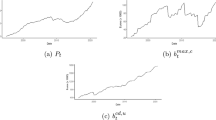Abstract
This article uses Bayesian vector autoregressive models to examine the usefulness of leading indicators in predicting U.S. home sales. The benchmark Bayesian model includes home sales, price of homes, mortgage rate, real personal disposable income, and unemployment rate. We evaluate the forecasting performance of six alternative leading indicators by adding each, in turn, to the benchmark model. Out-of-sample forecast performance over three periods shows that the model that includes building permits authorized consistently produces the most accurate forecasts. Thus, the intention to build in the future provides good information with which to predict U.S. home sales. Another finding suggests that leading indicators with longer leads outperform the short-leading indicators.
Similar content being viewed by others
References
Arnott, R. (1987).“Economic Theory and Housing.'' In E.S. Mills (ed.), Handbook of Regional and Urban Economics (vol. 2, Urban Economics pp. 959–988). Amsterdam: North-Holland.
Cullity, J. P., and G. H. Moore. (1990).“Long-Leading and Short-Leading Indexes” In G. H. Moore, Leading Indicators for the 1990s (ch. 9). Irwin, IL: Dow-Jones.
Doan, T. A. (1990). Regression Analysis of Time Series. Evanston, IL: VAR Econometrics.
Doan, T. A., R. B. Litterman, and C. A. Sims. (1984).“Forecasting and Conditional Projection Using Realistic Prior Distributions” Econometric Reviews 3, 1–100.
Dua, P., and S. M. Miller. (1996).“Forecasting Connecticut Home Sales in a BVAR Framework Using Coincident and Leading Indexes” Journal of Real Estate Finance and Economics 13, 219–235.
Dua, P., and S. C. Ray. (1995).“A BVAR Model for the Connecticut Economy” Journal of Forecasting 14, 217–227.
Dua, P., and D. J. Smyth. (1995).“Forecasting U.S. Home Sales Using BVAR Models and Survey Data on Households' Buying Attitudes for Homes” Journal of Forecasting 14, 167–180.
Fildes, R., and S. Makridakis. (1995).“The Impact of Empirical Accuracy Studies on Time Series Analysis and Forecasting” International Statistical Review 63, 289–308.
Litterman, R. B. (1981).“A Bayesian Procedure for Forecasting with Vector Autoregressions” Working Paper, Federal Reserve Bank of Minneapolis.
Litterman, R. B. (1986).“Forecasting with Bayesian Vector Autoregressions: Five Years of Experience” Journal of Business and Economic Statistics 4, 25–38.
Makridakis, R., C. Chatfield, M. Hibon, M. Lawrence, T. Mills, K. Ord, and L. S. Simmons. (1993).“The M2-Competition: A Real-Time Judgmentally Based Forecasting Study” International Journal of Forecasting 9, 5–22.
Megbolugbe, I. F., A. P. Marks, and M. B. Schwartz. (1991).“The Economic Theory of Housing Demand: A Critical Review” Journal of Real Estate Research 6, 381–393.
Moore, G. H. (1981).“A New Leading Index of Employment and Unemployment” Monthly Labor Review 104, 44–47.
Moore, G. H. (1985).“Forecasting Unemployment with the Leading Employment Index” Economic Forecasts 268–273.
Schwartz, M. B. (1988).“The Estimation of Housing Demand: A Review of the Research and its Implications” Working Paper, Forecasting and Policy Analysis Division, National Association of Realtors.
Sims, C. A. (1980).“Macroeconomics and Reality” Econometrica 48, 1–48.
Sims, C. A. (1988).“Bayesian Skepticism on Unit Root Econometrics” Journal of Economic Dynamics and Control 12, 463–474.
Sims, C. A., J. H. Stock, and M. W. Watson. (1990).“Inference in Linear Time Series Models with Some Unit Roots” Econometrica 58, 113–144.
Smith, L. B., K. T. Rosen, and G. Fallis. (1988).“Recent Developments in Economic Models of Housing Markets” Journal of Economic Literature 26, 29–64.
Spencer, D. E. (1993).“Developing a Bayesian Vector Autoregression Forecasting Model” International Journal of Forecasting 9, 407–421.
Theil, H. (1971). Principles of Econometrics. New York: J Wiley.
Todd, R. M. (1984).“Improving Economic Forecasting with Bayesian Vector Autoregression” Quarterly Review (Federal Reserve Bank of Minneapolis) (Fall), 18–29.
Zellner, A. (1979).“Statistical Analysis of Econometric Models” Journal of the American Statistical Association 74, 628–643.
Zellner, A., and F. Palm. (1974).“Time Series Analysis and Simultaneous Equation Econometric Models” Journal of Econometrics 2, 17–54.
Author information
Authors and Affiliations
Rights and permissions
About this article
Cite this article
Dua, P., Miller, S.M. & Smyth, D.J. Using Leading Indicators to Forecast U.S. Home Sales in a Bayesian Vector Autoregressive Framework. The Journal of Real Estate Finance and Economics 18, 191–205 (1999). https://doi.org/10.1023/A:1007718725609
Issue Date:
DOI: https://doi.org/10.1023/A:1007718725609




